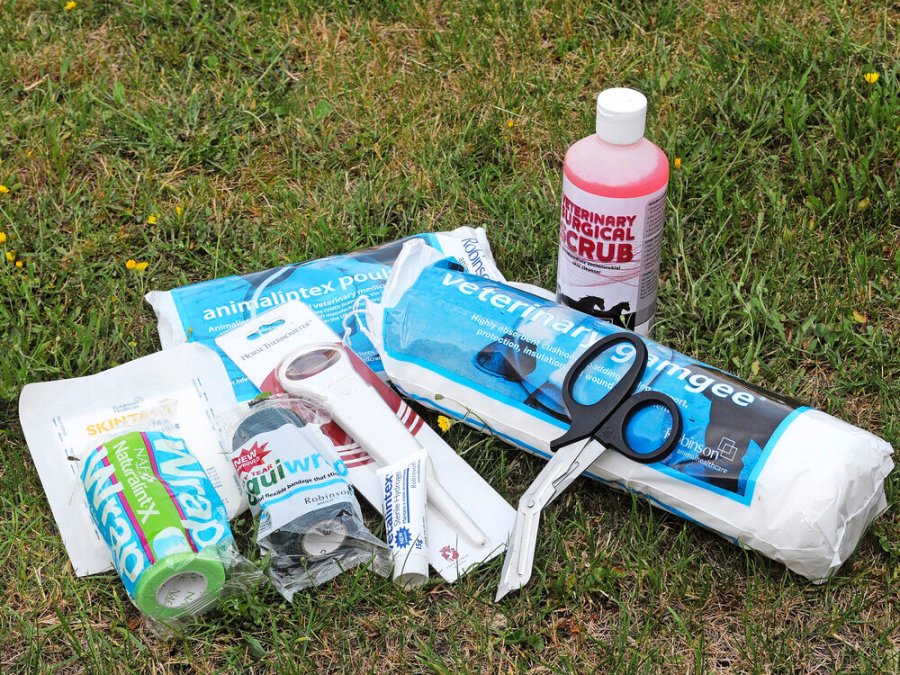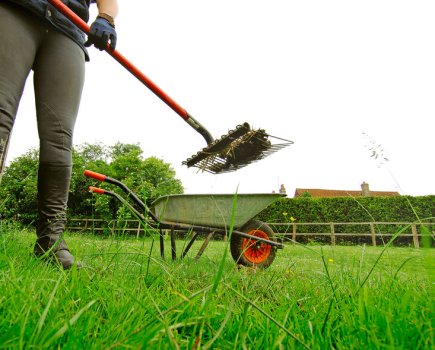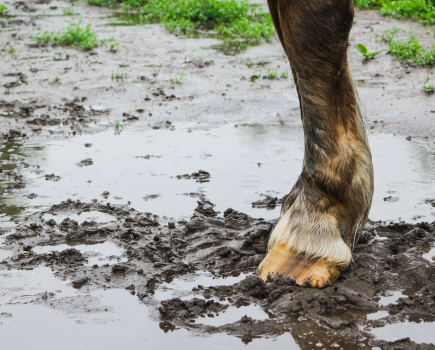Every horse owner should have an equine first aid kit in their tack room that is well stocked with health products and useful items. I keep one in my horsebox too, so that I’ve always got one to hand.
Experience tells me that when you discover your horse is injured or hurt, the last thing you want to be worrying about is where your first aid kit is or what your horse health insurance policy number is. Injuries can and will happen — often when you least expect it — so it’s best to be prepared by keeping a well stocked equine first aid kit.
Useful horse health products
Vet Alistair Love MRCVS from Clevedale Vets Equine recommends that your equine first aid kit is stored somewhere clean, dry and within easy reach when you need it urgently.
Here are some useful horse health products to have inside it:
Cotton wool
Cotton wool is useful for compression of bleeding wounds, or for cleaning wounds. It’s also a handy, soft, absorbent layer for a bandage.
Hibiscrub
A bottle of Hibiscrub is helpful for using in low concentrations for wound cleaning.
Poultice pads
A hoof poultice pad is always handy — these can be used dry or soaked warm to help a horse with a corn, solar bruising and, of course, for an abscess.
Non-stick dressing
A primary non-stick dressing, like Melolin, to put on a wound before applying a bandage should be in your first aid kit.
“Some soft bandage like Orthoband or Soffban is useful to then go over the horse’s leg before the cotton wool layer of a bandage,” says Alistair.
Cohesive bandages
You will need a couple of cohesive bandages like Vetrap in your first aid kit to use when poulticing a hoof. They are particularly useful for this job as the bandage sticks to itself as you build up the layers of the poultice.
“In my experience, the thicker, higher-quality Vetraps are much better as they stick well and don’t wear through as quickly,” says Alistair. “Ideally, they want to be 10cm in width so that they provide good broad coverage; the cheaper, smaller ones are usually a false economy.
Important warning about Vetrap in first aid kits
You may need to use Vetrap on a limb if your horse has a dressing that needs holding in place on a leg wound.
It is easy to do Vetrap too tight though, as it is stretchy, and this is very bad for a horse’s legs.
Before using a cohesive bandage on limbs make sure you know how to apply a bandage safely, otherwise you can cause a nasty bandage bind.
Never put a Vetrap on a horse’s leg without a smooth, even layer of something soft like Gamgee or Animalintex first.
The Vetrap shouldn’t attach to the horse’s body, so make sure there is a centimetre or so of Gamgee still in view underneath it.
Remember not to apply it too tight.
Barrier cream
“A barrier cream like FiltaBac is good for keeping superficial wounds clean when the horse is turned out. It can also be used as total sunblock for pink or sunburnt noses,” says Alistair.
A barrier cream to protect legs from mud fever is a good thing to have to hand too.
Digital thermometer
A digital thermometer in your first aid kit is worthwhile. There are many times when a vet may ask you to check or monitor your horse’s temperature if they are unwell, so long as it is safe to do so and you are confident doing it correctly.
Gloves
Every time your vet visits to assess a wound, you’ll notice they always put on a fresh pair of medical gloves first. You should do the same before cleaning a wound.
Clean latex, vinyl or nitrile gloves will help to make sure you don’t introduce infection. It also keeps your hands protected.
Scissors
Don’t forget to include a pair of scissors in your first aid kit as you’ll need these for cutting a poultice or Gamgee to size.
Small tub
A small tub that is kept clean (and ideally sterile) will come in handy for holding clean water that you can use to wash a wound or soak a piece of Animalintex.
Salt
For small nicks and cuts that aren’t deep or on a joint, adding salt to the clean water you are using to wash the wound will help clean it.
Wound cream
There are plenty of these on the market and you could ask your vet which they recommend. Wound cream should only be used on small cuts and nicks. Don’t apply any cream or ointment to wounds until your vet has seen it and advised you what to do.
Emergency contacts
Keep a copy of contact numbers inside a first aid kit so that the relevant people can be contacted quickly.
People to include are your vet, farrier, insurance company (write down your policy number too), horse’s owner and yard manager (if applicable). Include your own number in there as well.
The easier it is to get hold of everyone in an emergency situation the quicker it will be.
If you’re not there, the person who is may not have these numbers stored on their phone — and don’t count on your own phone having enough battery to make a call either.
Other useful horse health products
It is useful to have a set of stable bandages and leg pads (or leg wraps) in your tack room.
Should your horse suffer a wound to the back of their lower leg, for example, you can dress the wound and then keep it clean and protect it further by applying a stable bandage on top.
Alternatively, you could use leg wraps, which do a similar job and are quicker and easier to put on.
Make sure you apply stable bandages on top of a leg pad and always bandage legs in pairs — so both both forelegs or both hindlegs at the same time.
Manuka honey
“Manuka honey can be helpful in some cases to promote wound healing and prevent infection, but it is very important to use medical manuka honey,” warns Alistair.
“Supermarket-bought honey can carry a risk of botulism when applied to wounds.”
Storing horse health products
Items in your equine first aid kit must be clean, fresh and sterile if they are going to do their job properly.
Therefore, it is imperative that you store them in a clean, sturdy container that can be closed or a bag that can be done up.
Don’t forget to replace any horse health products you use so that your first aid kit is always well stocked.
Human first aid kit
Remember, riders get injured too, so it’s a good idea to have some items to treat human wounds as well.
When to call your vet
My final piece of advice is to remember that your vet is the best person to assess a wound, no matter how big or deep or where it is located on your horse.
Wounds on a joint, for example, are always serious and require a call out even if they look innocuous. Even if you are a very experienced horse owner, pick up the phone and talk to your vet about what you see.









